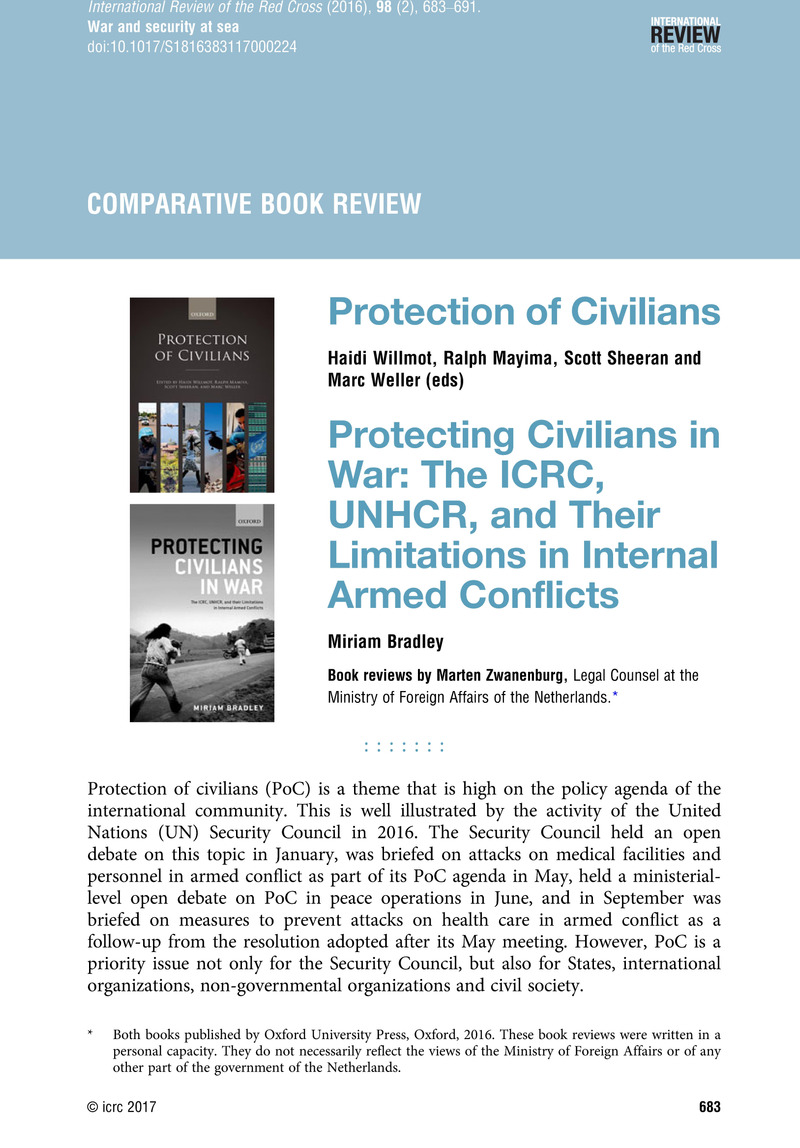No CrossRef data available.
Article contents
Protection of Civilians Haidi Willmot, Ralph Mayima, Scott Sheeran and Marc Weller (eds) - Protecting Civilians in War: The ICRC, UNHCR, and Their Limitations in Internal Armed Conflicts Miriam Bradley
Published online by Cambridge University Press: 19 May 2017
Abstract

- Type
- Books and articles
- Information
- International Review of the Red Cross , Volume 98 , Issue 902: War and security at sea , August 2016 , pp. 683 - 691
- Copyright
- Copyright © icrc 2017
Footnotes
Both books published by Oxford University Press, Oxford, 2016. These book reviews were written in a personal capacity. They do not necessarily reflect the views of the Ministry of Foreign Affairs or of any other part of the government of the Netherlands.
References
1 Scott Sheeran and Catherine Kent, “Protection of Civilians, Responsibility to Protect, and Humanitarian Intervention: Conceptual and Normative Interactions”, in Protection of Civilians, p. 43.
2 See, in particular, the updated Commentary on Article 1 of the first Geneva Convention. ICRC, Commentary on the First Geneva Convention: Convention (I) for the Amelioration of the Condition of the Wounded and Sick in Armed Forces in the Field, Geneva, 2016Google Scholar, available at: ihl-databases.icrc.org/applic/ihl/ihl.nsf/Comment.xsp?action=openDocument&documentId=72239588AFA66200C1257F7D00367DBD (all internet references were accessed in February 2017).
3 Siobhan Wills, “International Responsibility for Ensuring the Protection of Civilians”, in Protection of Civilians, p. 225.
4 Ibid., p. 232. Wills refers in particular to UN Security Council Resolution 1996, which included a requirement for the United Nations Mission in the Republic of South Sudan of “immediately reporting gross violations of human rights to the UN Security Council”. UNSC Res. 1996, 8 July 2011, para. 3(b)(iii).
5 For more detail, see the reviewer's contribution to a symposium on the blog Opinio Juris in which the chapter by Wills is discussed, available at: opiniojuris.org/2016/09/07/protection-of-civilians-symposum-some-thoughts-on-legal-obligations-for-un-peacekeeping-operations-to-protect-civilians/.
6 For a discussion of this issue, see inter alia Zwanenburg, Marten, “The Interplay of International Humanitarian Law and International Human Rights Law in Peace Operations”, in de Wet, Erika and Kleffner, Jann (eds), Convergence and Conflicts of Human Rights and International Humanitarian Law in Military Operations, Pretoria University Law Press, Pretoria, 2014, p. 53Google Scholar.
7 Lise Grande, “The Problems and Dilemmas of Helping to Build Protection Capacities”, in Protection of Civilians, p. 405.
8 The proposed definition reads: “‘Protection of civilians’ is the act of protecting from violence and minimizing harm toward those not directly participating in hostilities, in conflict situations. Such acts are undertaken pursuant to the rights and responsibilities of national authorities, belligerents, and the international community, and are governed by a legal framework of positive and negative obligations based on the UN Charter, IHL, IHRL, and refugee law. In this context, the state of being protected manifests primarily as a fulfilment of the rights to life and physical integrity, whether citizen or alien. Direct protection activities are those that have a proximate casual [sic] connection resulting in the immediate and direct physical protection of civilians. Indirect protection activities are those that have a less proximate casual [sic] connection vicariously resulting in the protection of civilians.”




